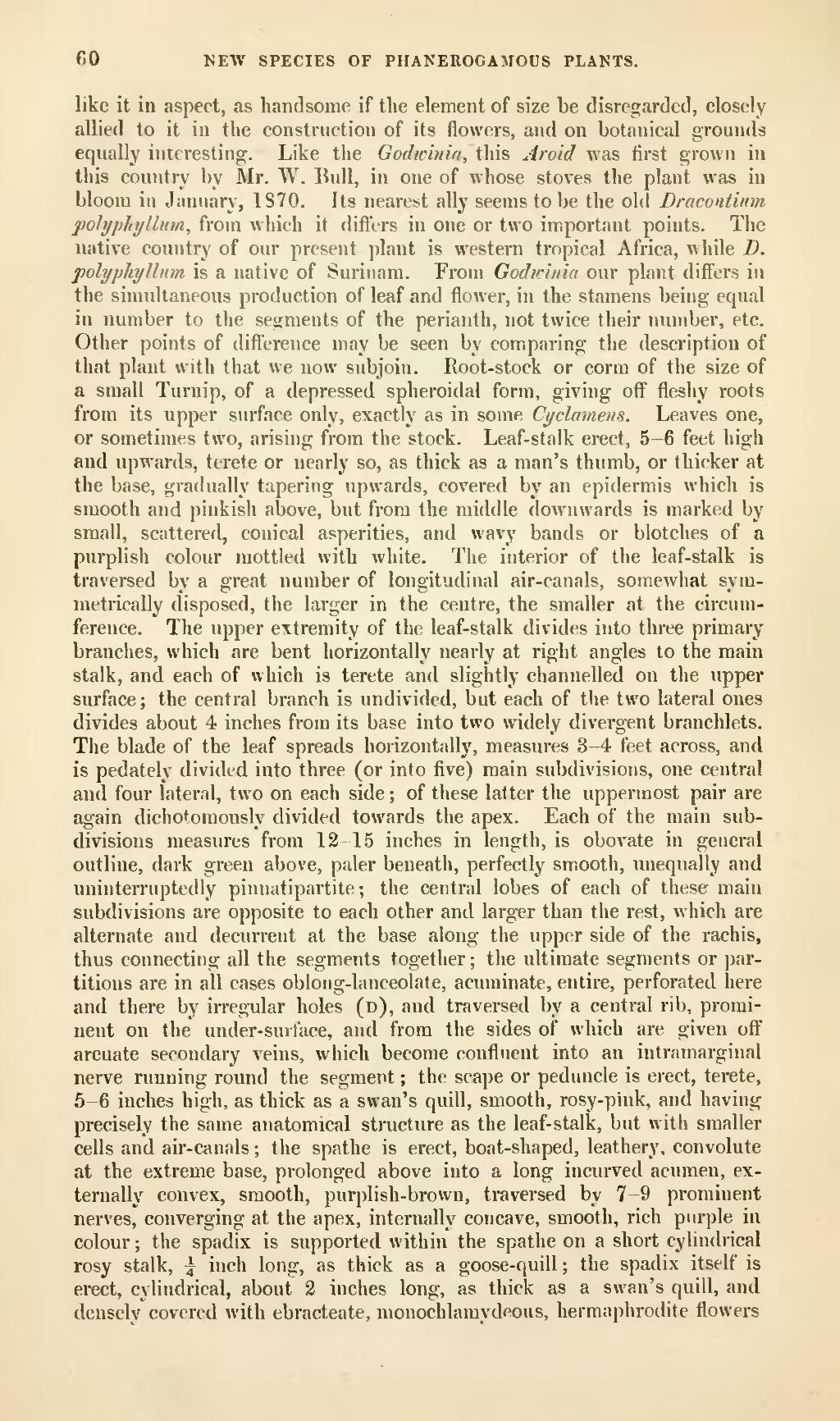TiO NEW SPECIES OF PHANEROGAMOUS PLANTS.
like it in aspect, as handsome if the element of size be disregarded, closely allied to it in the construction of its flowers, and on botanical grounds equally interesting. Like the Godtcitiia, this Aroid was first grown in this country by Mr. W. Bull, in one of whose stoves the plant was in bloom in January, 1870. Its nearest ally seems to be the old Dracontium poly phj Hum, from which it differs in one or two important points. The native country of our present plant is western tropical Africa, while D. polyphylluni. is a native of Surinam. From Godicinia our plant differs in the simultaneous production of leaf and flower, in the stamens being equal in number to the segments of the perianth, not twice their number, etc. Other points of difierence may be seen by comparing the description of that plant with that we now subjoin. Root-stock or corm of the size of a small Turnip, of a depressed spheroidal form, giving off fleshy roots from its upper surface only, exactly as in some Cyclamens. Leaves one, or sometimes two, arising from the stock. Leaf-stalk erect, 5-6 feet high and upwards, terete or nearly so, as thick as a man's thumb, or thicker at the base, gradually tapering upwards, covered by an epidermis which is smooth and pinkish above, but from the middle downwards is marked by small, scattered, conical asperities, and wavy bands or blotches of a purplish colour mottled with white. The interior of the leaf-stalk is traversed by a great number of longitudinal air-canals, somewhat sym- metrically disposed, the larger in the centre, the smaller at the circum- ference. The upper extremity of the leaf-stalk divides into three primary branches, which are bent horizontally nearly at right angles to the main stalk, and each of which is terete and slightly channelled on the upper surface; the central branch is undivided, but each of the two lateral ones divides about 4 inches from its base into two widely divergent branchlets. The blade of the leaf spreads horizontally, measures 3-4 feet across, and is pedately divided into three (or into five) main subdivisions, one central and four lateral, two on each side ; of these latter the uppermost pair are again dichotomously divided towards the apex. Each of the main sub- divisions measures from 12-15 inches in length, is obovate in general outline, dark green above, paler beneath, perfectly smooth, unequally and uninterruptedly pinnatipartite; the central lobes of each of these main subdivisions are opposite to each other and larger than the rest, which are alternate and decurrent at the base along the upper side of the rachis, thus connecting all the segments together; the ultimate segments or par- titions are in all cases oblong-lanceolate, acuminate, entire, perforated here and there by irregular holes (d), and traversed by a central rib, promi- nent on the under- surface, and from the sides of which are given off arcuate secondary veins, which become confluent into an intramarginal nerve running round the segment ; the scape or peduncle is erect, terete, 5-6 inches high, as thick as a swan's quill, smooth, rosy-pink, and having precisely the same anatomical structure as the leaf-stalk, but with smaller cells and air-canals ; the spathe is erect, boat-shaped, leathery, convolute at the extreme base, prolonged above into a long incurved acumen, ex- ternally convex, smooth, purplish-brown, traversed by 7-9 prominent nerves, converging at the apex, internally concave, smooth, rich purple in colour; the spadix is supported within the spathe on a short cylindrical rosy stalk, ^ inch long, as thick as a goose-quill ; the spadix itself is erect, cylindrical, about 2 inches long, as thick as a swan's quill, and densely covered with ebracteate, monochlamydcous, hermaphrodite flowers
�� �
